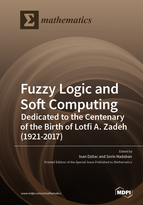Fuzzy Logic and Soft Computing – Dedicated to the Centenary of the Birth of Lotfi A. Zadeh (1921-2017)
A special issue of Mathematics (ISSN 2227-7390). This special issue belongs to the section "Fuzzy Sets, Systems and Decision Making".
Deadline for manuscript submissions: closed (31 December 2021) | Viewed by 28864
Special Issue Editors
Interests: fuzzy logic; fuzzy spaces; fuzzy programming; fuzzy decision-making; soft computing
Interests: fuzzy logic; fuzzy functional analysis; fuzzy spaces; fuzzy decision-making
Special Issues, Collections and Topics in MDPI journals
Special Issue Information
Dear Colleagues,
In 1965, Lotfi A. Zadeh published “Fuzzy Sets”, his pioneering and controversial paper, which has now reached over 115,000 citations. Zadeh’s papers have together been cited over 248,000 times (Google Scholar).
Starting from the ideas presented in that paper, Zadeh later founded the Fuzzy Logic Theory, which proved to have useful applications from consumer to industrial intelligent products.
In accordance with Zadeh’s definition, soft computing (SC) consists of computational techniques in computer science, machine learning, and some engineering disciplines to study, model, and analyze very complex reality, for which more traditional methods have been either unusable or inefficient.
SC uses soft techniques, contrasting it with classical artificial intelligence hard computing (HC) techniques, and includes fuzzy logic, neural computing, evolutionary computation, machine learning, and probabilistic reasoning.
HC is bound by a computer science (CS) concept called NP-complete, which means that there is a direct connection between the size of a problem and the amount of resources needed to solve that called the “grand challenge problem”. SC helps to surmount NP-complete problems by using inexact methods to give useful but inexact answers to intractable problems.
SC became a formal CS area of study in the early 1990s. Earlier computational approaches could model and precisely analyze only relatively simple systems. More complex systems arising in biology, medicine, the humanities, management sciences, and similar fields often remained intractable to HC. It should be pointed out that the simplicity and complexity of systems are relative, and many conventional mathematical models have been both challenging and very productive.
SC techniques resemble biological processes more closely than traditional techniques, which are largely based on formal logical systems, such as Boolean logic, or rely heavily on computer-aided numerical analysis (such as finite element analysis).
SC techniques are intended to complement HC techniques. Unlike HC schemes, which strive for exactness and full truth, SC techniques exploit the given tolerance of imprecision, partial truth, and uncertainty for a particular problem. Inductive reasoning plays a larger role in SC than in HC. SC and HC can be used together in certain fusion techniques.
SC can deal with ambiguous or noisy data and is tolerant of imprecision, uncertainty, partial truth, and approximation. In effect, the role model for SC is the human mind. Artificial intelligence and computational intelligence based on SC provide the background for the development of smart management systems and decisions in the case of ill-posed problems.
We are pleased to invite you and your collaborators to submit several papers for the Special Issue “Fuzzy Logic and Soft Computing”, which is dedicated to the centenary of the birth of Lotfi A. Zadeh (1921–2017).
Prof. Dr. Ioan Dzitac
Prof. Dr. Sorin Nadaban
Guest Editors
The Guest Editor Prof. Dzitac passed away on 6 February 2021. We thank him for his contributions to this special issue. Co-Guest Editor Prof. Nadaban is managing the special issue with the Editorial office and suggests retaining Prof. Dzitac's information on the special issue homepage.
Manuscript Submission Information
Manuscripts should be submitted online at www.mdpi.com by registering and logging in to this website. Once you are registered, click here to go to the submission form. Manuscripts can be submitted until the deadline. All submissions that pass pre-check are peer-reviewed. Accepted papers will be published continuously in the journal (as soon as accepted) and will be listed together on the special issue website. Research articles, review articles as well as short communications are invited. For planned papers, a title and short abstract (about 100 words) can be sent to the Editorial Office for announcement on this website.
Submitted manuscripts should not have been published previously, nor be under consideration for publication elsewhere (except conference proceedings papers). All manuscripts are thoroughly refereed through a single-blind peer-review process. A guide for authors and other relevant information for submission of manuscripts is available on the Instructions for Authors page. Mathematics is an international peer-reviewed open access semimonthly journal published by MDPI.
Please visit the Instructions for Authors page before submitting a manuscript. The Article Processing Charge (APC) for publication in this open access journal is 2600 CHF (Swiss Francs). Submitted papers should be well formatted and use good English. Authors may use MDPI's English editing service prior to publication or during author revisions.
Keywords
- fuzzy mathematics
- soft computing
- fuzzy logic
- fuzzy sets theory
- neuro-fuzzy applications






